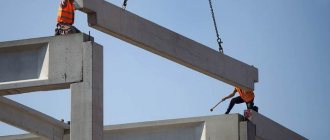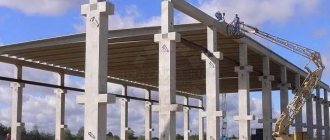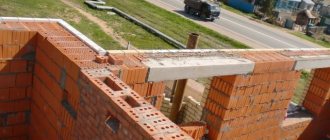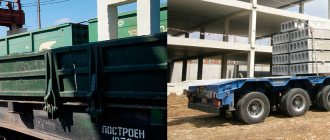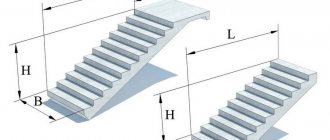Benefits of use
Reinforced concrete products extend the service life of electrical supports for decades. This significantly reduces the cost of their maintenance and is an undeniable advantage, since the wooden supporting structure quickly deteriorates. The production of racks quickly pays for itself, so these products are economically viable for mass production. Series 33, PT 43-2 consoles meet all the requirements of GOST 14295-75, such as:
- specifications;
- production;
- storage;
- installation.
View "GOST 14295-75" or
Reinforced concrete products marked 33, 43-2 are considered the most reliable structures.
Thus, the reliability of products is under state control and their operation is acceptable everywhere. One of their advantages is the ability to select reinforcement and concrete that meet the required parameters. Depending on the climatic conditions of the area, suitable supports are selected. Products of the PT 43-2 series are particularly durable, frost-resistant, and moisture-resistant. They can withstand magnitude 9 earthquakes and gusty winds.
Reinforced concrete attachments
Reinforced concrete attachments are special structural support elements that are intended for securing wooden or reinforced concrete supports of overhead power lines with voltages from 0.38 to 35 kV. In addition to power transmission line supports, reinforced concrete attachments are used as foundation structures to which telephone and telegraph communication supports, as well as lighting poles, are attached.
Reinforced concrete attachments (or stepsons) allow the construction of power transmission line supports to be carried out at a lower cost than the construction of overhead lines erected on traditional mushroom-shaped foundations or piles. Reinforced concrete attachments are used, as a rule, in areas characterized by a temperate climate, and in places where lines with a low rated voltage are installed, up to 35 kV, for example, in private gardens and summer cottages. Reinforced concrete attachments are also widely used in the construction of wooden supports - in order to increase their service life.
The main area of application of reinforced concrete attachments is energy construction. However, the versatility of the design allows these reinforced concrete products to be used in many other areas of construction. The use of reinforced concrete for the manufacture of attachments allows the construction of overhead lines in areas where the air temperature varies from +45°C to -55°C. Reinforced concrete, immersed in the ground, unlike other building materials, is able to withstand multiple freezing cycles even with high moisture saturation, and is also resistant to earthquakes with a seismicity index of up to 9 points inclusive.
Reinforced concrete attachments are pillars with a trapezoidal cross-section along their entire length. Reinforced concrete attachments are mated to the racks using both wire bands and fitting clamps. Attachments are applied to the racks not from above, but from the side, so that the plane of their interface is vertical. In case of significant loads on the support, as well as in areas with insufficiently dense soil (for example, swampy areas, quicksand, etc.), the support post is mounted on two attachments.
Reinforced concrete attachments are manufactured in accordance with GOST 14295-75 “Reinforced concrete attachments for wooden supports of overhead power transmission and communication lines” and series 3.407-57/87 “Reinforced concrete attachments for overhead power transmission and communication lines up to 25 kV” from heavy concrete of class B25 in strength for compression. Concrete classes for frost resistance and water resistance under conditions of alternating freezing and thawing in a non-aggressive and slightly aggressive environment are assigned to at least F200 and W4, respectively - at temperatures below -40°C, F150 and W2 (in a non-aggressive environment) or W4 (in an aggressive environment) - at temperatures above -40°C.
Reinforced concrete attachments are reinforced with welded spatial frames or knitted frames with spiral transverse reinforcement, depending on the technological capabilities of the manufacturer. The longitudinal rods of the frames are made of periodic steel of class A-III. When operating attachments in aggressive environments, class A-II steel is used. Transverse reinforcement is made from cold-drawn smooth wire of classes B-I, BP-I or from hot-rolled round steel of smooth profile of class A-I. Mounting loops are made of hot-rolled smooth reinforcing steel of class A-I.
As the main material for the longitudinal reinforcement of reinforced concrete attachments, reinforcement made of hot-rolled steel rods of periodic profiles of classes A-III and A-IV or heat-strengthened steel rods of classes At-IVC and At-IVK, which have a lower consumption of reinforcement compared to class A reinforcement, can be used -III.
Reinforced concrete attachments in accordance with GOST 14295-75 are designated by the letters PT (trapezoidal attachment) and two numbers (through a dash), the first of which means the value of the normalized design bending moment in the direction perpendicular to the axis of the communication and power transmission line in ton-meters at the ground level attachments into the ground, the second is the length of the attachment in meters.
Reinforced concrete attachments in accordance with series 3.407-57/87 are marked with one, two or three alphanumeric groups separated by hyphens. The first group contains the name of the prefix (PT – trapezoidal prefix) and its length in decimeters. The second group contains a symbol for bearing capacity. The additional letter designation of the third group indicates: “m” – the possibility of use in areas with an estimated air temperature below -40°C; “b” – possibility of use in conditions of exposure to mildly aggressive environments.
You can not only order reinforced concrete attachments, but also consult with our specialists and select the required designs of reinforced concrete products. In our sales department you can find out and clarify the price of reinforced concrete attachments in advance and calculate the total cost of the order. You can buy reinforced concrete attachments and consult on general issues of purchase and delivery by calling: St. Petersburg , Moscow , Krasnodar: (861) 279-36-00 . Company operating hours: Mon-Fri from 9-00 to 18-00. carries out delivery of reinforced concrete attachments throughout Russia directly to the customer’s site or to the construction site, if infrastructure allows.
For questions regarding the installation of reinforced concrete attachments, please contact us by phone.
In what area is it used?
Reinforced concrete attachments are used as support or reinforcement for power poles.
Used as a supporting structure for cable communications: power lines (telephone, satellite).
Attachments are suitable for strengthening wooden posts and lengthening posts. Reinforced concrete stepchildren of type PT 43-2 are used in different latitudes with anomalous natural phenomena. Acceptable areas of application
| A natural phenomenon | Indicators |
| Low temperature readings | Up to -55 degrees Celsius |
| Increased seismic activity | Up to 9 points on the Richter scale |
| Freezing/defrosting | Multiple |
Areas of application
The series of reinforced concrete products, within which PT 33 (33-3, 33-4), as well as 43-2 were developed, was created by order of the Soviet relevant ministry. The project was completed in 1987, and in 1988, after passing all the necessary approvals, it was approved.
Now these trapezoidal products have become widespread, serving as supports for power lines (voltage from 0.38 to 35 kilovolts), telephone lines, and other types of cable communications. They are also used to lengthen pillars when arranging intersections and strengthening wooden posts.
Thus, a product with index PT 43-2, for example, has such characteristics as frost resistance (up to -55 °C) and strength. It does not absorb moisture and can withstand a magnitude 9 earthquake and strong wind pressure.
Materials needed
In the production of stepsons, heavy concrete (vibrated) is used, reinforced with steel reinforcement. Product components: Portland cement, water, large aggregates. Manufacturing is controlled by standards. The fittings are treated to prevent rust. Due to the high compaction of the concrete mixture, the products have good strength.
Marking
After making the stepson, markings are applied to it, which indicate the length and permissible load on the product.
Information about the stepson includes alphabetic and numerical values that are indicated in the marking. The structures have the shape of a trapezoid; when they are marked, they are marked with a code of letters indicating the shape of the stepson (PT - trapezoidal prefix). Information about the technical characteristics is contained in numbers: product length (first number), permissible load (second value), load-bearing capacity (indicated by the last number). When the stepson is made and it has hardened, the marking is applied; it does not wash off.
How are they labeled?
The markings of the stepsons (numbers and letters) contain information about the name of the reinforced concrete product, the length of the product in decimeters (the first number) and the maximum load that the structure can withstand - its load-bearing capacity (the number after the hyphen). So, the letter “cipher” PT just means a trapezoidal prefix.
Indelible marking is applied after the reinforced concrete product has completely hardened and has already been removed from the mold. According to the state standard, the signs are located in its middle part; a stamp confirming the passage of technical control can be found at the end of the stepson - this is acceptable.
Production and installation features
The process of making consoles is divided into the following stages:
- preparatory process, including preparation of fittings and forms;
- reinforcement;
- The final stage is pouring concrete into the forms.
It is necessary to monitor the concrete during the hardening period in order to identify the defect in time and eliminate it. Among the flaws are:
- formation of depressions;
- the occurrence of influxes;
- depressions near the edges.
Reinforced concrete attachments are mounted using special equipment. A unit is installed on the tractor or a vibrator is used, with their help the attachment is placed in the ground. It is not recommended to use a pile driver, as it destroys the base of the concrete and compresses the reinforcement. When installing stepchildren in soft soil, they are strengthened with special supports.
Features of reinforced concrete attachments
The purpose of using reinforced concrete PT attachments is to fix wooden and reinforced concrete power transmission poles in areas with insufficiently dense soil or when it is necessary to extend the support. In areas with rather weak soil, each support post can be fixed simultaneously to 2 attachments. During construction, in order to create a vertical interface plane, the PT attachments are fixed to the racks on the side using special fitting clamps or wire bands.
Trapezoidal attachments (PT) are straight, elongated reinforced concrete products that have a trapezoidal cross-section and bevels at the ends. To make them comfortable to transport and install, the design has special mounting lifting loops. Due to the high strength of the material, the stepsons are able to withstand strong wind loads, as well as a large amount of ice on power lines. They also have the following advantages:
- copes well with low and high temperatures;
- are characterized by high resistance to cracking;
- not subject to rotting.
The presented structures are often used to increase the service life of wooden poles, or as foundation structures to which lighting, telegraph or telephone communications will be attached. Properly mounted PT stepchildren perfectly extend the life of overhead line poles.
Installation in the ground
Installation of attachments is carried out exclusively using special equipment. A reinforced concrete pillar is immersed in the ground using industrial vibrators, or it is pressed with a unit mounted on a tractor. A pile driver (pile driver) is not used: this can lead to destruction of the concrete base and exposure of reinforcement. If the installation of stepsons takes place in soft soil, they are reinforced with reinforced concrete or wooden support beams (crossbars). The base for mounting attachments can be either specially prepared or not.
Storage and transportation
Storage of reinforced concrete stepsons, according to the rules, is carried out in stacks, on wooden pads. The height of one such stack is no more than 4 rows (the attachments in each are selected according to the diameter); wood is also used between the rows as a spacer. According to standards, stacks must be protected from the sun.
Reinforced concrete attachments are transported, observing certain precautions. To avoid mechanical damage, the supports are loaded/unloaded using mechanical lifts or manually. In this case, the mounting loops must be secured in two places equidistant from. During such work, products should not be subjected to sharp shocks, jerks, impacts, or dropped.
>
The stepsons are delivered to their destination by transport adapted for such transportation; during the “trip” the elements, as during storage, are arranged with wooden spacers. The bottom row attachments must be of the same diameter. Place them tightly next to each other and tie them tightly.
Weight and size of attachments
Tables 1 and 2 provide information on the dimensions and weight of reinforced concrete attachments to supports in accordance with GOST 14275-75 and series 3.407.57/87.
Table
Weight and dimensions of attachments series 3.407.57/87
| Name | Length L, mm | Width A, mm | Width B, mm | Height H, mm | Weight, tons | Volume of concrete, cubic meters | Concrete | Steel, kg. |
| PT 30 | 3000 | 100 | 140 | 170 | 0.152 | 0.061 | B25 | 13.2 |
| PT 33-4 | 3250 | 100 | 180 | 220 | 0.250 | 0.1 | B25 | 29,5 |
| PT 33-2 | 3250 | 100 | 180 | 220 | 0.250 | 0.10 | B25 | 20.2 |
| PT 33-3 | 3250 | 100 | 180 | 220 | 0.250 | 0.10 | B25 | 26.1 |
| PT 33-4 | 3250 | 100 | 180 | 220 | 0.250 | 0.10 | B25 | 34.1 |
| PT 43-2 | 4250 | 100 | 180 | 220 | 0.325 | 0.13 | B25 | 44.3 |
| PT 43-3 | 4250 | 100 | 180 | 265 | 0.325 | 0.13 | B25 | 49.5 |
| PT 43-4 | 4250 | 100 | 180 | 265 | 0.325 | 0.13 | B25 | 55.2 |
